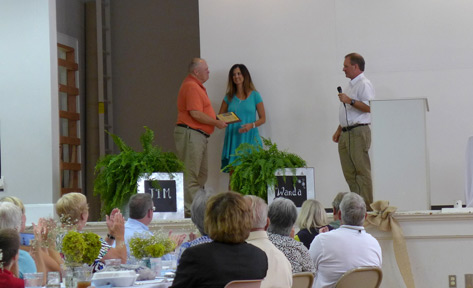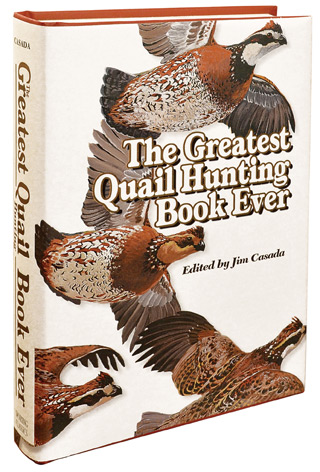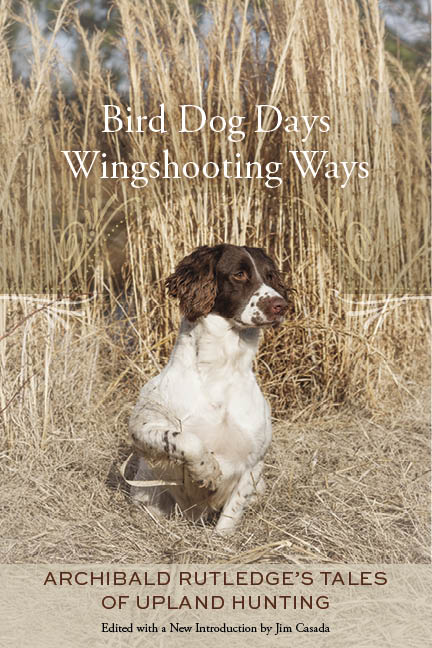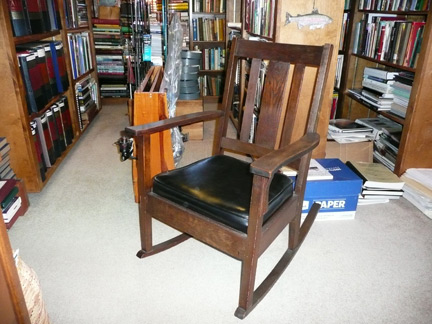October 2016 Newsletter
Click here to view this newsletter in a .pdf with a white background for easy printing. Jim’s Doings
Beyond that, I attended the recent annual meetings of both
the South Carolina Outdoor Press Association
(SCOPe) and the
Southeastern Outdoor Press Association
(SEOPA). I was blessed to
win some awards for my writing endeavors in the excellence in
craft competition sponsored by each organization, and I finished
out my rotation through the offices of SEOPA (my second time
around after a hiatus of about 20 years) by completing my term
as chairman of the board.
Along with the recognition for my writing, which is always gratifying, there was a real surprise awaiting me at the SCOPe gathering. Pat Robertson, a longtime colleague and the founding president of the group some 30 years ago, “roasted” me with a sometimes gratifying, sometimes gut-wrenching (but true) look at my career as an outdoor writer. He did the roast in conjunction with presenting me the organization’s first ever “Lifetime Achievement Award.” The recognition came complete with a framed artistic caricature of this homely soul which now decorates my den wall, and whenever I gaze at it I’ll do my darndest to remember the plentiful proud moments in my career rather than recalling the time I failed to take any matches on a backcountry camping trip I was guiding or another occasion when I came perilously close to child abuse (that was when my oldest nephew found my closing a truck tailgate on the tip of a prized fly rod hilarious). Along with the various awards for my writing and the Lifetime Achievement recognition came my induction into the Fly Fishing Museum of the Southern Appalachians Hall of Fame I mentioned last month, and I think it’s fair to say this has been one of the most memorable periods of my entire career as a writer. Mind you, I also retain sufficient self-awareness to know that these recognitions are in no small part the product of sheer persistence and longevity as a writer. Indicative of that is the fact that I’ve served as outdoor columnist for the local daily newspaper for almost 40 years, and my place on the masthead of Sporting Classics magazine, first as a Contributing Editor, then Senior Editor, and for the last couple of decades as Editor at Large, now stretches out over all but the first of that publication’s 35+ years of existence. I dreamed of being an outdoor writer as a kid, and I know full well how blessed I have been to have spent decades living that dream. I’ll be making a couple of appearances in my beloved Smokies in November in case any of you who are among my readers live in the area or might be visiting.
I’m including several photos connected with the two above-mentioned honors, and in one of them (below) you’ll see that sometimes rather homely old fellows like me can have attractive offspring. It was really special to have my daughter on hand to present the Hall of Fame plaque to her Dad.
This Month's Book Special
The book, with the perhaps questionable title The Greatest Quail Book Ever (I didn’t choose the title so don’t accuse me of delusions of grandiosity), does bring together selections from the greatest quail writers ever—Robert Ruark, Havilah Babcock, Nash Buckingham, Archibald Rutledge, Jack O’Connor, David Henderson, Horace Lytle, Dr. Joseph Greenfield, and a host of others –along with eye-catching artwork from the likes of Lynn Bogue Hunt and Shep Foley. There’s a section devoted to great short stories on bird hunting and bird dogs, and even a guide to the literature of the sport.
Or, if you are looking for a special gift for hunting friends, I’ll offer this book and my recent collection of Archibald Rutledge’s work in this field, Bird Dog Days, Wingshooting Ways (list price $29.95), for $60 for the pair, and I’ll pay the postage. That’s a savings of $12.50. OCTOBER IS FOREVER All things considered, I reckon October has to rate as my favorite month, although I could make a mighty good case for April and May. Normally I’d do my best to point out some of the many appealing things which make October so special, but this time I’m going to take another track. Those of you who are regular readers will be familiar—maybe all too familiar—with my Grandpa Joe. He figures regularly in these newsletters for the simple reason that he figured regularly in my boyhood. Other than my parents, he was probably as close and consistent a presence, and influence, on me as anyone in those starry-eyed days of youth. No one else in the family was nearly as close to him, perhaps because there’s no denying that Grandpa Joe had some issues. He distrusted mankind in general, was more than a bit paranoid, simply refused to work for anyone who insisted on directly overseeing him (never mind that he was no stranger to hard word or hard times), and possibly had a touch of dementia. For me though, he was a paragon of patience, a man with a world of accumulated practical wisdom, and most of all, just a buddy. We shared a lot of good times together, and every moment of fishing with him, every session of sitting entranced while he relived outdoor experiences from the 19th century, left me enchanted. Much of his telling of tales was done from rocking chairs, and the heart of this month’s offering focuses on a tribute to his favorite rocking chair. It now sits two steps from where these words are being typed, and I look at it many times every day and enjoy a second or two of glimpses of the past. It was a piece that won recognition in both the SCOPe and SEOPA craft competitions, and one judge in the latter organization’s contest was especially kind in his comments on the piece: “The power of this story makes the reader sit in the room and ponder the empty rocker along with the writer. As a piece of outdoor writing it is a masterpiece.” I don’t know about that, but I can say in all sincerity that it’s a heartfelt tribute to a man I dearly loved. Some of you will have read bits and pieces of this before, but here’s the whole cloth as it originally appeared in the February 18, 2016 edition of the Smoky Mountain Times, the little weekly newspaper in my boyhood home of Bryson City, N.C. Virtually all of my paternal grandfather’s storytelling, no matter what the season, occurred in one of two settings. The first was outdoors. There we shared countless treasured hours together, and for me they were precious whether we were fishing; piddling around making slingshots or gee haw whammy diddles; or hard at work performing mundane tasks such as hoeing corn, slopping hogs, or feeding chickens.
Today the latter chair rests two steps from where these words are being typed. I seldom sit in it, although its solid oak frame and cushioned seat are inviting. Instead, I just gaze on it and evoke memories of the old man who used it as a perch. It’s a comfort and a companion; an inspiration in my work and a constant invitation to revisit yesteryear. A conservative estimate would put its age somewhere beyond the century mark, and in its glory days what stories it heard. There were accounts of the glory days of that monarch of the Appalachian forests, the American chestnut. Grandpa would talk about trees so tall a shotgun load had no effect on squirrels feeding in their uppermost reaches or relate how the tree was a veritable staff of life when he was in his prime. Chestnut trees furnished acid wood and mast for “cash money” in what was mostly a barter-based economy; were the source of material for shingles, fence rails, and rough lumber for barns and corn cribs; provided food directly in forms such as roasted nuts and chestnut dressing; and indirectly through fattening up hogs and attracting wild game. Grandpa was tough as a well-seasoned hickory shaft, but when he talked about the days before a virulent blight devastated millions of acres of chestnut-dominated forest there would be a catch in his voice and moisture in his eyes. The old rocking chair moved in rhythm with his sad recollections, soothing and calming as he talked of a world he and countless others had lost. The chair knew gladness as well as sadness, such as when he described the antics of a tow sack full of cottontails caught in a deep soft snow and released in a one-room shack or when he would chuckle about how some innocent mischief on our part had raised the ire of Grandma Minnie. There were moments of high adventure too, such as when Grandpa recalled the time shot and killed a cougar in mid-air as it leaped from the roof of a chicken coop or the time when the family moved by wagon over treacherous mountain terrain in the dead of winter. Most of all though the chair offered a place of rest and comfort to an aging man of the mountains. In it, year after wonderful year, Grandpa showed me that dreaming is not the exclusive preserve of the young. You just had to be young at heart. That was one of his most enduring, endearing qualities. Grandpa Joe never saw the ocean, but he fished in pristine mountain streams and drank sweet spring water so icy it set your teeth on edge. He never drove a car but he handled teams of horses and understood meaningful application of the words gee, haw, and whoa. If he ever left the state of North Carolina it was just to venture a few miles into north Georgia, but he lived a full life in mountains so lovely they make the soul soar. To my knowledge he never once ate in a restaurant, but he dined on sumptuous fare—pot likker, backbones and ribs, fried squirrel with sweet potatoes, country hams from hogs he had raised and butchered, cathead biscuits with sausage gravy, cracklin’ cornbread, and other fixin’s the likes of which no high-profile chef could best. I can still hear him, as he returned thanks, offering a simple prayer which always ended: “You’uns see what’s before you; eat hearty.” He would then do ample justice to one of Grandma Minnie’s scrumptious suppers before pronouncing, “My, that was fine, weren’t it.” Those words were more expressive and conveyed greater appreciation than any polished literary comments a food critic could possibly provide. Grandpa never drank a soda pop, but he sassered, sipped, and savored pepper tea he prepared from parched red pepper pods like a connoisseur of the finest wines. He never tasted seafood, but he dined on speckled trout battered with stone-ground corn meal fried so perfectly you could eat ‘em bones and all. He never ate papayas or pomegranates, but he grew cannonball watermelons so sweet they’d leave you sticky all over and raised muskmelons so juicy that when one was sliced you drooled despite yourself. He never had crepes suzette, but he enjoyed buckwheat pancakes made with flour milled from grain he had grown, adorned with butter his wife churned, and covered with molasses made from cane he raised. He never ate eggs Benedict, but he dined daily on “cackleberries” from free-range chickens with yolks yellow as the summer sun. Grandpa was marginally literate, having completed six grades in a country school where sessions were only held for a few months each year, but he faithfully read the Bible every day. He seldom went to church, at least in the years I knew him, but he was an intensely religious man. In short, Grandpa Joe was not, in the grander scheme of things, an individual who garnered fame or fortune, accolades or noteworthy achievements. His life was one of limitations in many ways—geographically, technologically, economically, in breadth of vision, and at least in the eyes of some, accomplishments. To my way of thinking though, he epitomized love; the magic of mentoring; liberal dispensation of that most precious of gifts, time; and sharing of down-to-earth lore redolent of the wisdom inherent in singer/songwriter John Prine’s suggestion that “it don’t make much sense that common sense don’t make no sense no more.” He was, in my small world, the most unforgettable character I’ve ever known or likely will ever know, and the chair that is now my daily sidekick saw and heard so much of his life formed the centerpiece of those cherished memories. For more than four decades now the chair has primarily known the sounds of silence, but a mere glance at it calls back wonders of yesteryear in a way that lifts my spirits and stirs my innermost being. I reckon, all things except monetary worth being duly considered, that the old rocking chair is the finest thing I own. Recipes FRIED APPLE PIES We had a small hillside orchard when I was a boy, and the months of September and October meant apple-picking time and all the many delights that went with a fruit that did exceptionally well in the North Carolina high country. Mom always canned scores of jars, made apple butter, and there was fruit stored in bins in the basement. We also dried apples, and one of my all-time favorite snacks/desserts was a product of dried apples. A fried apple pie featuring homemade crust and your own dried apples, rehydrated and cooked up just right with sugar and spice, is for me an irresistible treat. It’s fairly simple and here’s the basic recipe Mom used.
1 pound dried apples Rehydrate the dried fruit by covering it with water and soaking overnight. Drain, add a small amount of fresh water, and simmer slowly until cooked tender. Mash the cooked fruit and add the other ingredients. Stir thoroughly and then allow to cool. Prepare pie crust (or use commercially available crust, although to my way of thinking such crusts aren’t as good). Cut the crust into circles of about five inches in diameter and then place cooked apples on one side of the circle. Fold over and seal along the edge with a fork. Fry in piping hot lard, turning once as the pastry browns. Remove, drain on paper towels, and while still warm, brush with melted butter or sprinkle with cinnamon sugar. The resulting “half moons,” as they were sometimes called, are scrumptious whether served hot or cold. APPLE STACK CAKE Another dessert which utilized apple sauce made from dried apples was stack cake. This was the special province of Grandma Minnie, and she knew I enjoyed stack cake so much that even after I was grown and had finished undergraduate school she would often make one when she got word I would be returning home for a visit. She’d always prepare it three or four days in advance, because a stack cake is at its moist and tasty best after the sauce between each layer of cake has had time to spread its goodness by marrying with and moistening the cake. Here’s a recipe similar to how she made stack cake. Grandma did everything from memory, and I don’t recall her ever looking at a cookbook or recipe card. For the Layers of Cake
4 cups plain flour For the Filling between Layers 3 cups sweetened and spiced (with cinnamon) applesauce from dried apples Sift the flour, salt, soda, and baking powder. Cream the shortening and then add sugar, a bit at a time, blending well. Add molasses and mix thoroughly. Add milk and eggs, one at a time, beating thoroughly until smooth. Pour a third of an inch deep in greased nine-inch pans and bake until golden brown. When cool, stack the layers (this recipe should make six of them), spreading the applesauce between them. SQUIRREL CASSEROLE In today’s hunting world it seems most interest is in big game, but during my boyhood October meant squirrel hunting. I pursued bushytails with a passion and they appeared regularly on the family table. Momma normally prepared baked squirrel or squirrel and dumplings, but a squirrel casserole is mighty fine fixin’s.
4 squirrels, dressed Season meat with salt and pepper to taste. Flour the squirrels and brown in a roasting pan. Add remaining ingredients and bake at 350 degrees for 45-50 minutes. Reduce temperature until tender enough for meat to pull easily from the bone. DIJON MUSTARD VENISON BACKSTRAP I’ve always had a taste for mustard, from BBQ to ham sandwiches, and I thoroughly enjoy venison dishes which use mustard. Here’s a dandy way to combine Dijon mustard with backstraps (or tenderloins).
1/3
cup Dijon mustard Combine all batter ingredients and mix well; place in a shallow dish. Place bread crumbs in a second shallow dish. Dip venison steaks in batter to coat and then dredge in bread crumbs. Place canola oil in a non-stick skillet and cook steaks over medium-high heat. Cook about five minutes or until golden brown on both sides. Do not overcook and turn only once. Steaks should still be pink in the center. Serve at once. CUBED STEAK VENISON CHILI
1 pound cubed steak Place cubed steak in a crockpot and pour can of mushroom soup and a can of water atop it and cook for several hours until the meat is so tender it easily cuts with a fork. Remove from the crockpot and cut the meat into small pieces using game scissors of an ulu (Eskimo knife). Sauté onion. Place meat and soup mix, together with all other ingredients, in a large skillet or a stew pot. Stir thoroughly and heat until bubbling. Reduce to a slow simmer and allow the flavors to mix and match for an hour or more. Serve with a big pone of cornbread. VENISION FAJITAS
Thinly sliced strips of venison flank cut across the grain Quick fry the strips of venison in a skillet containing pre-heated canola oil. Sauté the onion in a separate pan. Steam tortillas. Mix meat and onions on a large serving dish while piping hot and serve with condiments in separate bowls, letting each person prepare their fajitas to individual preference. Thank you for subscribing to the
Jim Casada Outdoors
newsletter. |
||
|
Send mail to
webmaster@jimcasadaoutdoors.com with
questions or comments about this Web site. |

 The past six weeks or so have been incredibly busy and rewarding
for me. I’ve traveled more than any time since my beloved Ann
first began to evince signs of dementia, and in some ways at
least the travel has been conducive to peace of mind and a sort
of soul-soothing influence. In late September I took my first big
industry-related trip in a couple of years, joining Linda Powell
and Dave Miles of Mossberg for a delightful upland game hunt at
The past six weeks or so have been incredibly busy and rewarding
for me. I’ve traveled more than any time since my beloved Ann
first began to evince signs of dementia, and in some ways at
least the travel has been conducive to peace of mind and a sort
of soul-soothing influence. In late September I took my first big
industry-related trip in a couple of years, joining Linda Powell
and Dave Miles of Mossberg for a delightful upland game hunt at


 Amidst all the travel and folderol of recent weeks, I’ve
also been deeply immersed in my latest book project. It
involved compiling, editing, and doing some writing for
a book timed to appear in connection with the 50th
anniversary of the Grand National Quail Hunt in
Oklahoma.
Amidst all the travel and folderol of recent weeks, I’ve
also been deeply immersed in my latest book project. It
involved compiling, editing, and doing some writing for
a book timed to appear in connection with the 50th
anniversary of the Grand National Quail Hunt in
Oklahoma.  Signed and inscribed copies of the book, which is
a hefty one running to well over 300 pages, are
available from me for $35 plus $5 shipping and handling.
Signed and inscribed copies of the book, which is
a hefty one running to well over 300 pages, are
available from me for $35 plus $5 shipping and handling.
 The
second focal point for Grandpa Joe’s telling of tales came when he was
comfortably seated in a rocking chair. He actually had two of these
storytelling thrones. One was a wicker-bottomed rocker on the front
porch. Comfortably ensconced in it he could gaze out at the nearby
Tuckaseigee River and listen to its soothing whispers while calling back
old long ago. The second rocker was a more substantial piece of
furniture situated in the living room, and on bitter winter days or when
he was dog tired from hours of labor it was his place of rest and
retreat.
The
second focal point for Grandpa Joe’s telling of tales came when he was
comfortably seated in a rocking chair. He actually had two of these
storytelling thrones. One was a wicker-bottomed rocker on the front
porch. Comfortably ensconced in it he could gaze out at the nearby
Tuckaseigee River and listen to its soothing whispers while calling back
old long ago. The second rocker was a more substantial piece of
furniture situated in the living room, and on bitter winter days or when
he was dog tired from hours of labor it was his place of rest and
retreat.